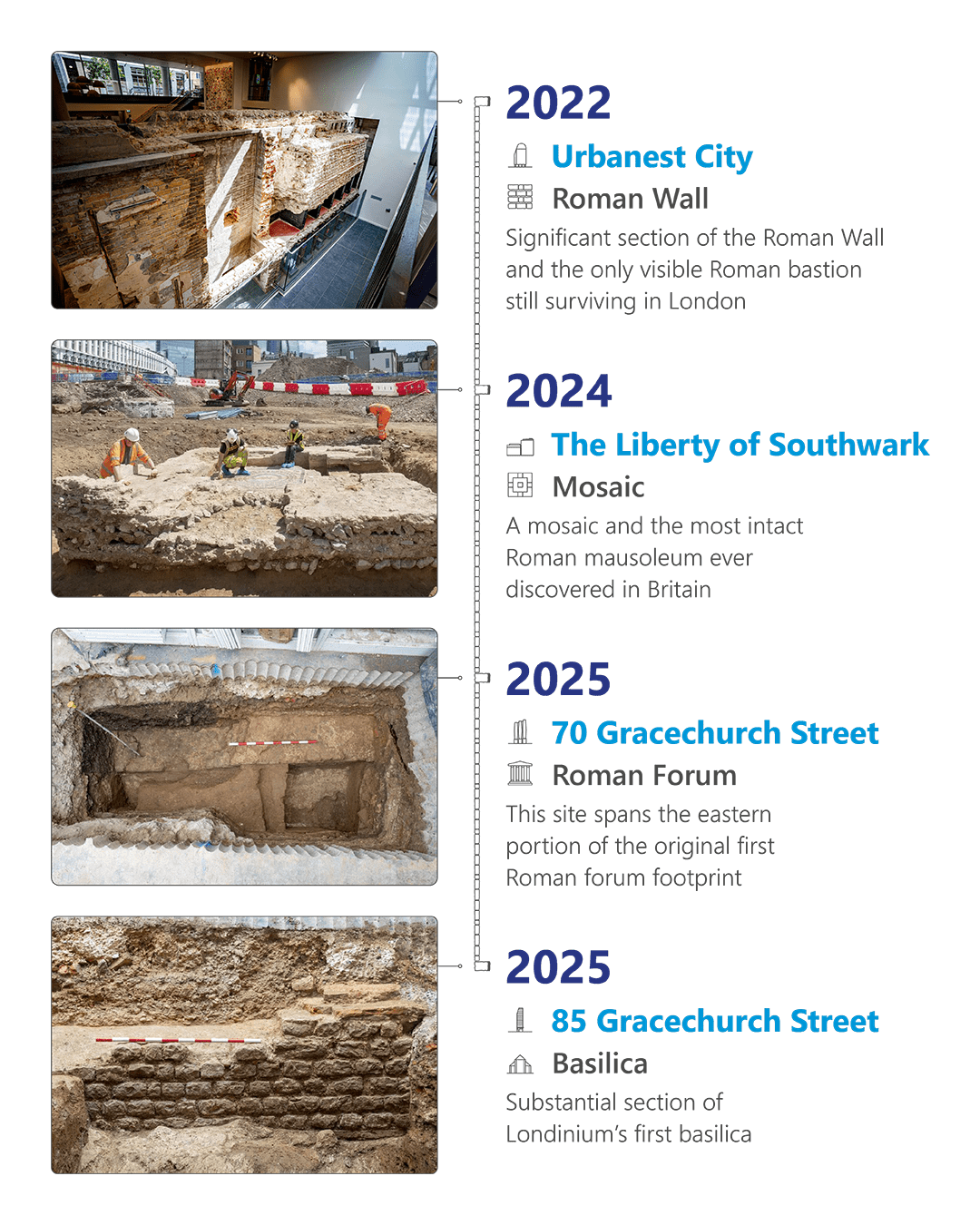- August 13, 2025
- 8:08 am
Robert Bird Group’s expertise on archaeologically significant sites

The discovery of a substantial section of Londinium’s first basilica, part of the original Roman forum, beneath our ongoing project at 85 Gracechurch Street, recently
made headlines worldwide. This fascinating glimpse into the city’s ancient past emphasises the importance of a meticulous approach when developing archaeologically significant sites. At Robert Bird Group, we have a track record of helping unlock London’s next chapter while safeguarding the city’s rich history. Our innovative engineering solutions help preserve the past while driving projects towards completion with minimal delays.
Preserving the Tribunal: 85 Gracechurch Street
Our experience spans a range of projects, each requiring a tailored approach to preserve the valuable historical remains discovered beneath them. At 85 Gracechurch Street, the western portion of the site covers approximately 340 square metres and contains the remains of the First Forum Basilica, including substantial Roman wall sections. These remains are of exceptional archaeological significance. Through early test trenches, archaeologists uncovered massive Roman foundations constructed from flint, ragstone and tile, with some sections measuring over ten metres in length, one metre wide and four metres deep. It is believed these remains form part of the “Tribunal”, a raised platform within the basilica where Roman officials and magistrates would once have presided over matters that shaped the political landscape of early London.
To help protect these remarkable remains, we established an archaeological exclusion zone within the site. This area was cleared of all foundations, and no structural columns were placed within it, removing any risk of physical intrusion. Above the exclusion zone, we designed a lightweight structural framing system to support a glass-paved floor – this will enable visitors to get a clear view of the Roman walls below while maintaining stability and safety. Our strategy follows a bottom-up approach, with a logistics slab installed early in the programme, allowing archaeological investigations to continue below while construction progresses above. With both activities proceeding in parallel, we’re able to minimise disruption and speed up the overall programme. Following demolition, a full archaeological excavation will be undertaken, and a permanent exhibition space will be created within the basement, much like the popular London Mithraeum beneath Bloomberg HQ. This space will provide a unique opportunity for the public to stand above the foundations of the Tribunal, immersing visitors in what was once the beating heart of Roman London.
Engineering around the Forum: 70 Gracechurch Street
We are also engaged in the neighbouring development at 70 Gracechurch Street, a 33-storey adaptive reuse scheme that reimagines the former Marks & Spencer building. This site spans the eastern portion of the original first Roman forum footprint, linked to the Second Forum, which was constructed shortly after the first and was nearly five times as large. Its vast courtyard alone is thought to have rivalled Trafalgar Square in size. Construction of the existing building in the early 2000s saw the removal of much of the second forum archaeology, but remnants of the first forum remain in place. To protect the archaeological layers while enabling the new structure, we employed
cantilever transfer structures to shift loads away from the remaining archaeology, and adopted low-headroom, large-diameter piling methods to avoid further excavation in the basement. These strategies, developed early in the design, allowed us to balance conservation with commercial viability and deliver a modern, sustainable tower that respects the ancient city below.
Safeguarding Southwark’s Layers: The Liberty of Southwark
Our sensitive approach extends south of the river to The Liberty of Southwark, a mixed-use office and residential development behind Borough Market, where initial archaeological works unearthed a mosaic and the most intact Roman mausoleum ever discovered in Britain. Investigations revealed remains from across the prehistoric, Roman, medieval and post-medieval periods, including a Roman clay floor, Kentish ragstone demolition debris and a vertical plastered wall, just over 2.2 metres below ground. The site was classified as having very high archaeological risk in its central area, with heritage assets warranting preservation in place or full excavation. To minimise the impact on cost and programme, our engineering strategy incorporated the reuse of existing basements, early ground investigations and flexible structural designs that could adapt to discoveries made during construction. These risk-mitigation measures, developed in close collaboration with archaeologists, ensured the project could proceed without compromising the integrity of Southwark’s historic layers.
Revealing the Roman Wall: Urbanest City Development
The Urbanest City development presented another archaeological challenge, uncovering a significant section of the Roman Wall and the only visible Roman bastion still surviving in London. Originally constructed between AD 190 and AD 230, the wall once stretched over 3 kilometres around Londinium, built from Kentish ragstone and lined with distinctive red clay tile bands. The bastion, likely added in the 4th century as a defensive tower, features classic Roman stepped chalk foundations and was preserved beneath centuries of later development, having once been absorbed into workshops, homes and warehouses. To protect and showcase these remains, we designed a long-span steel grillage at Level 01 to create an open-plan basement museum space where the wall and bastion could be safely viewed. Adding to the complexity, the development also had to accommodate the Irongate Thames Water Sewer running beneath the site and was located adjacent to a medical centre with an MRI room. This increased the need for accuracy in load management and vibration control. Through close stakeholder collaboration and technical ingenuity, we helped transform this site into an accessible destination where London’s fascinating ancient history can now be explored.